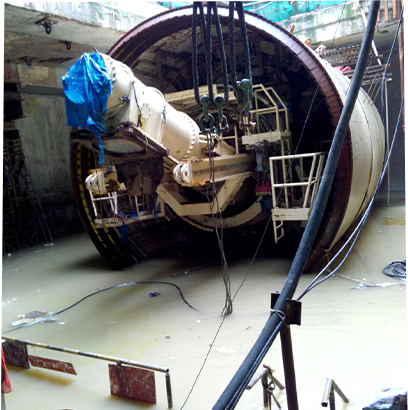
Fighting the odds, stemming the tide
December 2015 brought one of the fiercest floods in the history of Chennai. The entire city was flooded because of torrential rains and it had a big challenge thrown at Chennai Metro project team. Even as the team continued tunnelling, water started gushing into the shafts and even began flooding the TBM that was being assembled at Egmore station. The situation got out of hand on December 3, 2015, around 5am, despite all precautionary measures.
That’s when the site team quickly alerted the TBM team. The Super 7 - T Manoharan (Manager - Electrical), T Velmurugan (TBM Superintendent), S Vijayaraga (TBM Foreman - Mech), Sunil Kumar (TBM Mechanic), Sridhar (TBM Mechanic), Om Prakash Yadav (TBM electrician), and, Karthikeyan (TBM Electirical Supervisor) - rushed to the site immediately and pulled off a challenging TBM rescue.
The team noticed that the water level was increasing at an alarming rate. The machine inside the tunnel was also sinking and they immediately shut the HT electrical power of the tunnel. They reached the conclusion that it was impossible to dewater and had to take other drastic measures instead. Soon, two teams were formed – one team went in the shaft to remove costly components from S717 TBM, and the other went inside the S718 tunnel. And all they had was mobile torch lights. The teams recovered all the important components such as HMI & VMT Monitors, Master PLC CPU, I/P & O/P cards etc.
But the nightmare had just began. Once the components were removed, the water level was already above the walkway platform of the tunnel. That meant that the water level at the entrances of the tunnel was higher than what was inside the TBM. So, taking the components out safely through that route was out of question. The team took a decision and put them all inside the man lock and seal it. In that pressure situation, the team maintained its calm, and made sure that the man lock was pressurised to 1.5bar so that the pressure difference wouldn’t let water inside the man lock in case the entire tunnel sank.
Once the components were safeguarded, the team swam outside the tunnel and the team in the shaft ensured that the components were removed. By 9am, team completed all of this and also began helping the surface team to make dewatering arrangements. However, the downpour continued, and by noon, the water level was touching the screw discharge gate of TBM, 5m above base slab level. This caused the muck skips to float and move into the tunnel.
The team was determined not to let it affect the tunnel or TBM in any way. The team dived into the water again and dragged all the skips to the opening with the help of a rope and removed all buckets from the shaft area. If the team had let it go as the tunnel flooded, it would have been very difficult to get those skips out of tunnel after water draining. Because the skips were already separated from muck cars and would have settled in tricky positions inside the tunnel.
The team’s valiant effort not just saved the company a huge loss, but also ensured that the tunnelling was not affected substantially after the waters receded. It is people like them that have ensured that the project was completed smoothly, and the entire phase-I of Chennai Metro Rail is now operational.
We salute the Super 7!







